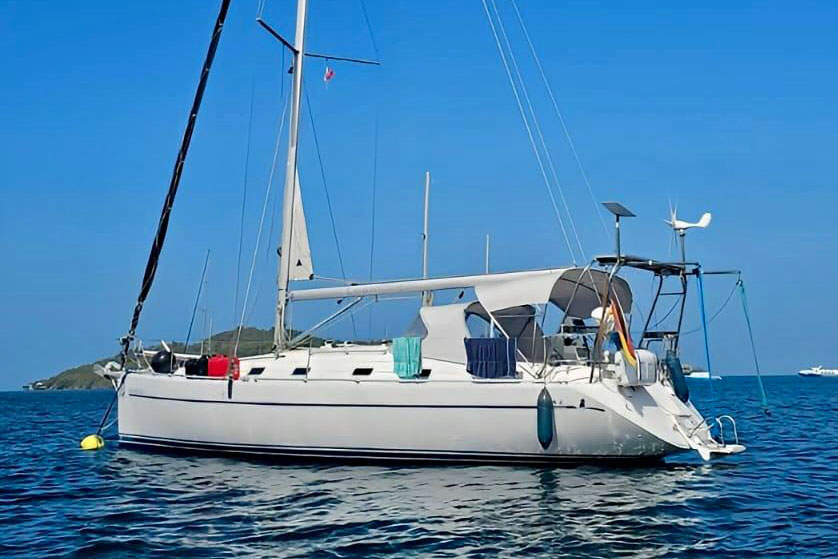- Home
- Cruising Yachts 40' to 45'
- Harmony 42 Sailboat
The Harmony 42 Sailboat
Specs & Key Performance Indicators
The Harmony 42 sailboat, an aft-cockpit fractional sloop, was designed by French designer Olivier Poncin and built in France by Poncin Yachts.
 A Harmony 42 at anchor
A Harmony 42 at anchorPublished Specification for the Harmony 42 Sailboat
Keel & Rudder Configuration: Fin keel with spade rudder
Hull Material: Fiberglass
Length Overall: 12.86 meters (42'2")
Waterline Length: 11.25 meters (36'11")
Beam: 3.95 meters (13'0")
Draft: 1.95 meters (6'5")
Rig Type: Fractional sloop
Displacement: 8,500 kilograms (18,739 pounds)
Ballast: 2,500 kilograms (5,512 pounds)
Designer: Olivier Poncin
Builder: Poncin Yachts
Year First Built: 2005
Year Last Built: 2009
Published Design Ratios for the Harmony 42
The Key Performance Indicators (KPIs)
The Harmony 42 sailboat's design ratios provide insights into its theoretical sailing characteristics:
- Sail Area/Displacement Ratio (19.2): This ratio indicates reasonably good performance. The Harmony 42 should have a balanced power-to-weight ratio, making it capable of decent speed and agility under sail.
- Ballast/Displacement Ratio (33.6): While this ratio suggests moderate stiffness and stability, it doesn't account for ballast placement. A higher ratio (40 or more) would indicate a stiffer boat, but the actual performance depends on whether the ballast is concentrated low in the keel or spread out.
- Displacement/Length Ratio (180): This places the Harmony 42 in the light displacement category. It implies that the boat requires less sail area to reach its hull speed, making it easier to handle and potentially faster in lighter winds.
- Comfort Ratio (26.0): This ratio suggests the Harmony 42 offers moderate comfort, suitable for coastal cruising. It indicates a balance between stability and motion comfort, though it may not be as comfortable in rough seas as heavier bluewater cruisers.
- Capsize Screening Formula (1.9): With a value below 2.0, the Harmony 42 is considered suitable for ocean passages, indicating good stability and reduced capsize risk.
These ratios are theoretical and have limitations. For instance, the Ballast/Displacement Ratio doesn't consider ballast placement, which significantly affects stability. Similarly, Ted Brewer's Comfort Ratio favours heavy, narrow-beamed vessels with long overhangs, potentially undervaluing modern light-displacement, beamy cruisers with plumb bows that may still offer good comfort and bluewater capability.
In conclusion, the Harmony 42 presents itself as a capable and well-rounded sailboat suited for coastal cruising and moderate bluewater passages, with good performance characteristics and a comfortable motion at sea. However, a detailed inspection beyond these ratios would be necessary to fully understand the nuances of its design, especially factors like ballast positioning and hull shape.
Here's how to calculate the KPIs yourself - without having to wrestle with the mathematics...
This article was written with the assistance of Gemini, a large language model developed by Google. Gemini was used to gather information, summarize research findings, and provide suggestions for the content and structure of the article.
Recent Articles
-
Sailboat Wheel Steering Maintenance & Inspection Checklist
Dec 30, 25 02:32 PM
Keep your vessel’s helm responsive and reliable with our expert maintenance checklist. Master cable tensioning and system inspections to avoid mid-passage failures. -
Modern Boat Electronics and the Latest Marine Instruments
Dec 20, 25 05:27 PM
Should sailboat instruments be linked to the latest boat electronics as a fully integrated system, or is it best to leave them as independent units? -
Hans Christian 43: Classic Bluewater Cruiser & Liveaboard Sailboat
Dec 10, 25 04:37 AM
Explore the Hans Christian 43: a legendary heavy-displacement, long-keel sailboat. Read our in-depth review of its specs, design ratios, and suitability for offshore cruising and living aboard.












